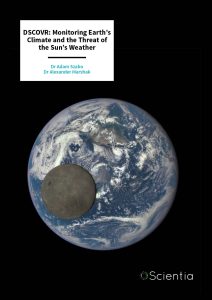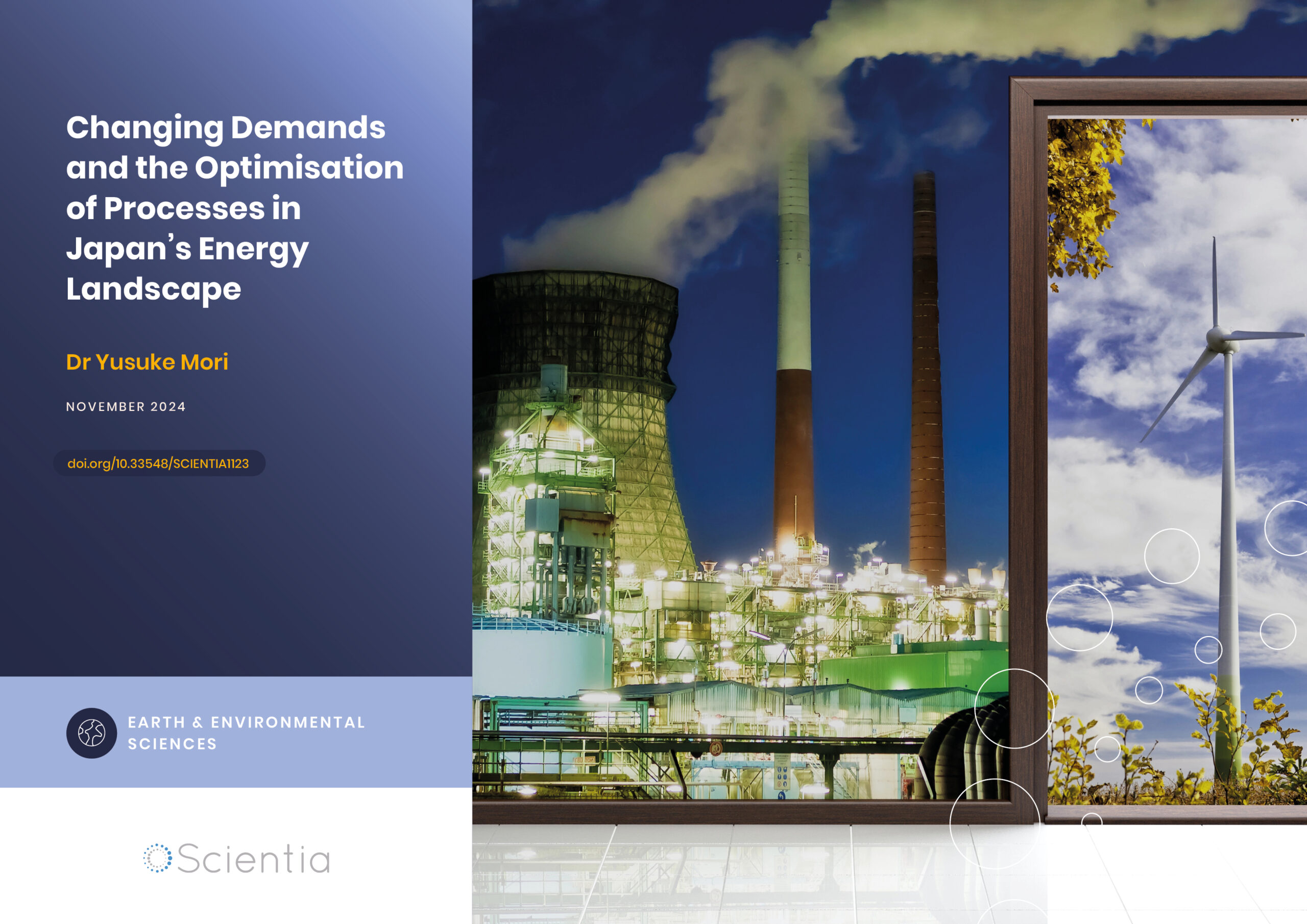Dr Adam Szabo | Dr Alexander Marshak – DSCOVR: Monitoring Earth’s Climate and the Threat of the Sun’s Weather
The Deep Space Climate Observatory – DSCOVR – is a satellite orbiting between the Sun and Earth at the first Sun-Earth Lagrange point. The primary mission of DSCOVR is to measure the incoming solar wind conditions and provide these measurements in near-real-time, to enable space weather forecasting. DSCOVR also has instruments that can monitor Earth’s climate, by measuring energy reflected and radiated from Earth, and can track levels of ozone, aerosols, clouds, vegetation and ocean properties, and more. Led by scientists Dr Adam Szabo and Dr Alexander Marshak, the project is a joint mission between National Oceanic and Atmospheric Administration (NOAA), the US Air Force, and NASA.
The Deep Space Climate Observatory
The Deep Space Climate Observatory – DSCOVR – was launched atop a SpaceX Falcon 9 rocket in early 2015. Its primary mission is to monitor the Sun’s weather near Earth. Its secondary objective is to provide novel Earth observations from a unique vantage point. To achieve these goals, the project is a collaboration between three major agencies.
The Air Force provided the launch vehicle, NOAA operates the spacecraft and its solar weather forecasting instrumentation, and NASA built the spacecraft itself, as well as operating the two Earth-facing science instruments.
Monitoring Earth’s climate requires a good view of Earth, of course. On the other hand, tracking solar weather is most useful when the satellite is closer to the Sun than the Earth is, so that it can act as an early warning system. However, if the satellite is closer to the Sun than Earth is, its orbit will be faster and it will not remain in the vicinity of Earth.
To resolve this conflict, DSCOVR travelled 1.5 million kilometres to a special point between the Earth and the Sun, called the first Sun-Earth Lagrange point, or L1. Here, the gravity from Earth and the Sun balance each other, and so the satellite can remain near the Sun-Earth line with few course corrections.
The L1 Lagrange point is perfect for space weather monitoring, as a satellite near this location can sample the incoming solar wind around 40 minutes before it reaches Earth. Thus, space weather forecasting on a 30-minute timescale is possible.
The L1 point also provides a unique vantage point for Earth science. From there, almost all of the sunlit face of Earth is visible, unlike from typical low-Earth orbits. This enables, for example, studies of how characteristics of the Earth system changes from morning through noon to evening. All of the DSCOVR images of Earth are uploaded online daily.
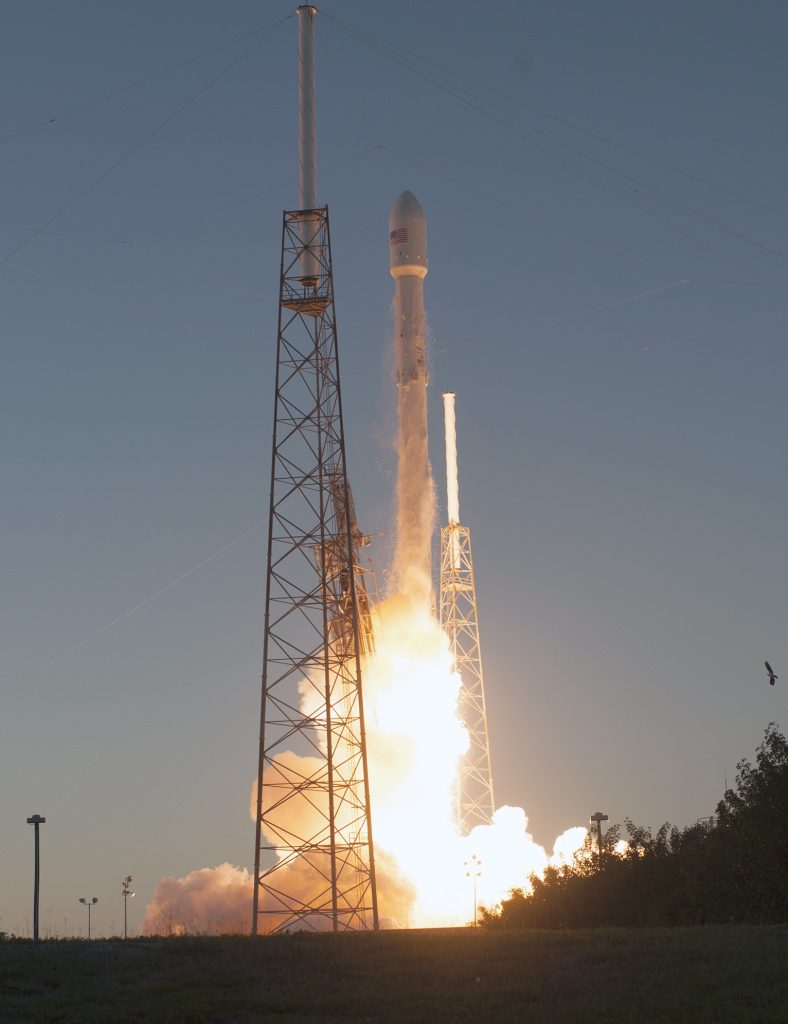
CREDIT: NASA/Tony Gray and Tim Powers
Monitoring the Health of Earth’s Climate
DSCOVR has two Earth-facing instruments – one that looks at broad-spectrum radiation, and one that is tuned to particular frequencies of radiation from ultraviolet to near-infrared spectral ranges.
The former is NISTAR, which measures how much energy is radiated and reflected from Earth towards the critical near-sunward direction. If more energy leaves the Earth system than the amount the Sun provides, the Earth will cool over time. However, if more energy is absorbed, the Earth will warm. This is called the planet’s radiation budget, and is key to tracking the progression of climate change, in both the short and long-term. The deeper understanding of Earth’s radiation budget provided by NISTAR will help scientists and decision makers to devise the most effective strategies to mitigate global climate change.
The second instrument is EPIC: the Earth Polychromatic Imaging Camera. This is a Cassegrain telescope with a 30-centimetre aperture. An aperture is the circular hole that lets light in: the larger the aperture, the more light that can enter, allowing more detail to be achieved. Cassegrain is a telescope design where light is first reflected by a concave mirror, which aims the light at a smaller convex mirror, which focuses the final image to a point.
So, how does EPIC help us monitor the climate? The air on Earth is transparent to many wavelengths – or ‘colours’ – of light. However, clouds, smoke, aerosols and certain molecules such as ozone can reflect certain wavelengths of light back into space, allowing them to be detected by EPIC.
EPIC is built to detect ten specific wavelength ranges of light. To do so, the telescope houses a wheel of filters. By rotating the wheel, the filter covering the sensing equipment can be switched – with each filter blocking all but a narrow range of wavelengths. Each wavelength range is chosen to detect certain molecules in the atmosphere.
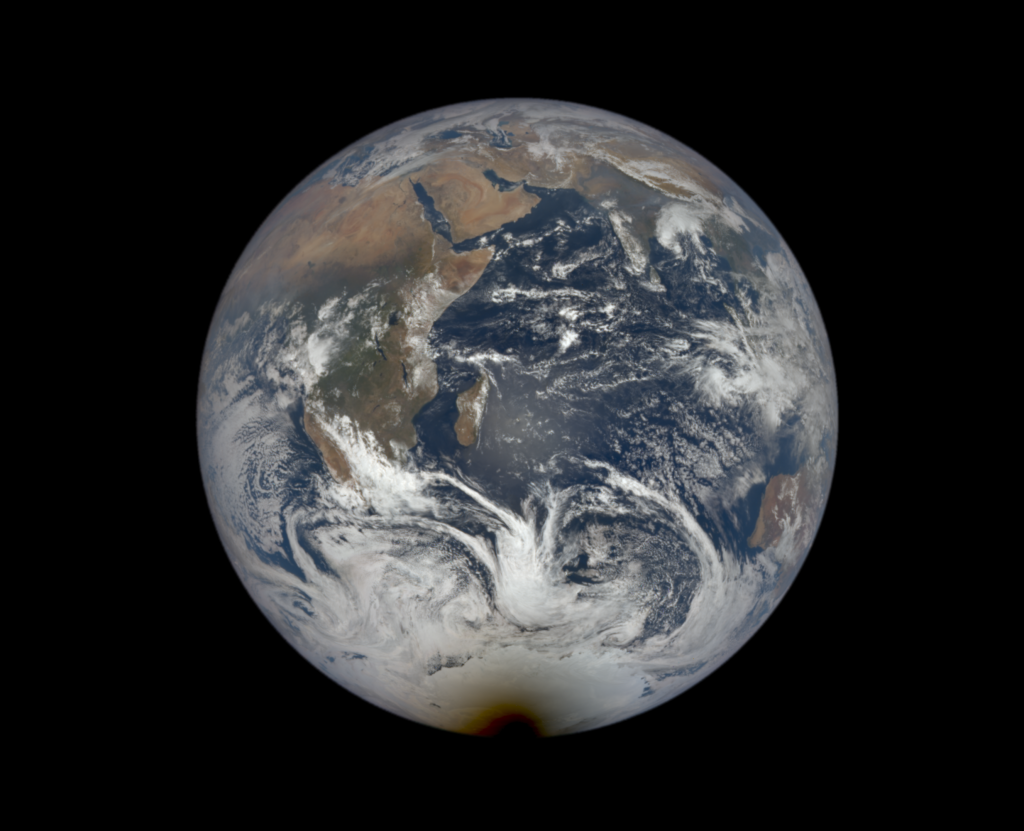
On December 4th, 2021, EPIC imaged a rare total solar eclipse in Antarctica from 1 million miles away
For example, one filter only lets through light with a wavelength of 317.5 nanometres. This lets EPIC detect ozone, an unstable molecule containing three oxygen atoms that forms when ordinary oxygen molecules are hit by ultraviolet light or, more excitingly, by lightning. Ozone rises to the upper atmosphere and protects life on the surface by absorbing 98% of the Sun’s harmful ultraviolet light.
The ozone layer can become depleted by the release of chemicals such as CFCs, used in refrigerators and propellants. As such, to monitor the ‘health’ of the atmosphere, EPIC keeps track of ozone levels and distributions in the atmosphere. The good news is that worldwide control and bans on the use of CFCs has slowed ozone depletion, allowing it to slowly recover.
Wavelengths of light detected through the other filters onboard EPIC allow scientists to examine aerosols in the atmosphere, study clouds, and even measure the density of vegetation.
The near-infrared radiation scattered by vegetation is very strong, allowing EPIC to see green leaves even through optically thin clouds. Since EPIC sees the radiation reflected by the brightest portion of the canopy, it allows scientists to directly measure the sunlit leaf area, while also estimating how individual leaves reflect solar radiation, which offers unique diagnostic information about the biochemistry of leaves.
Glints are caused by the reflection of sunlight from highly reflective objects. Such objects include the ocean or other water surfaces, and cloud ice crystals that reflect sunlight like a mirror consisting of numerous tiny pieces. EPIC offers excellent opportunities to learn about ice clouds that cause glints.
EPIC’s camera generates images of 2,048 x 2,048 pixels. To reduce the transmission time to Earth, these images (except those recording blue light) are compressed to 1,024 x 1,024 pixels – roughly the size of a standard Instagram photo. The resolution is around 10 x 10 kilometres at the centre of Earth’s image, meaning that each pixel of the final image covers around 100 square kilometres of Earth’s surface, which the team verified by looking at the width of the Nile and Amazon rivers.
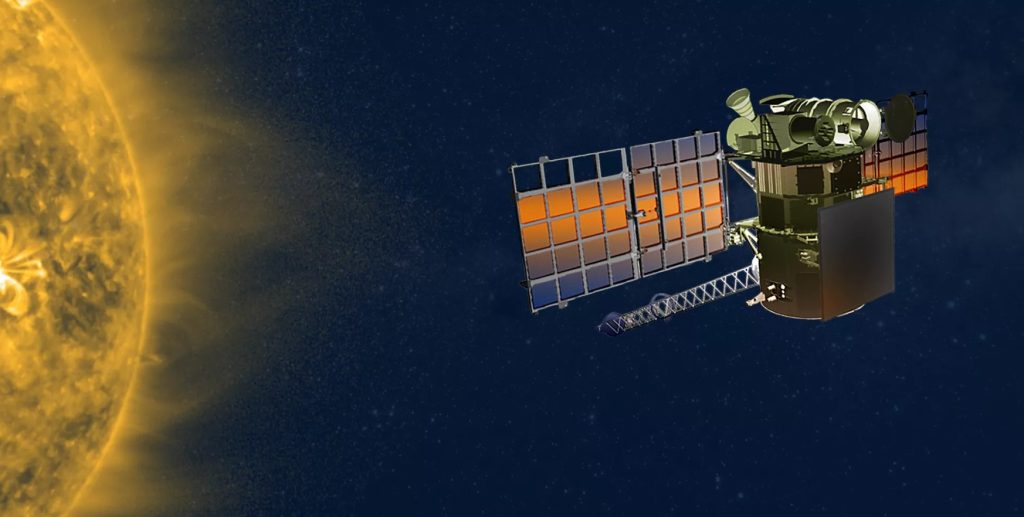
CREDIT: NOAA
A Warning System for Solar Activity
DSCOVR also watches the Sun, using the Plasma-Magnetometer – or PlasMag. This suite is composed of an instrument measuring the solar wind particles and a magnetometer observing the local magnetic fields. The Faraday Cup solar wind instrument detects the gale of charged particles including protons and alpha particles that are thrown from the outer layers of the Sun. Unlike the steady output of light and heat that life on Earth relies on, the solar wind is shockingly chaotic, as the intense magnetic fields within the Sun ebb, flow, and snap, energising the material to millions of degrees and launching charged particles, which flow outwards into space.
Most of this solar wind is harmless to us. Since it is made up of charged particles, the solar wind responds to magnetic fields. The molten iron in Earth’s outer core generates a strong magnetic field, which deflects most of these charged particles around Earth.
In the chaotic soup of the Sun’s surface and atmosphere, raging solar flares and other activities can lead to ‘coronal mass ejections’ or ‘CMEs’, where phenomenal amounts of charged particles and magnetic fields are flung from the Sun’s surface. CMEs can compress Earth’s magnetic field and cause havoc with our electrical grids and other infrastructure. They can also damage satellites orbiting Earth, severely disrupting our communication and navigation systems.
Luckily, very large coronal mass ejections are rare. In recent history, the most intense coronal mass ejection directed at Earth occurred in 1859. This was before the widespread use of electricity, though telegram operators were electrocuted as their cables became energised, and some even caught fire. Intense auroral displays were seen not just near the poles, but all around the world.
If such a large event occurred today, there would be widespread blackouts and permanent damage to electrical grids, which would likely cause tens of billions of dollars of damage each day in the US alone. The best way to protect against such an event is to predict them in advance and shut down or isolate electrical grids before the surge of charged particles reaches Earth. Vulnerable components on satellites can also be turned off to protect them. Thus, it is key to detect these events as early as possible, which one of DSCOVR’s key aims.
A Celestial Guardian
DSCOVR is a celestial guardian, keeping a watchful eye on the star that bathes the Earth with energy, sometimes destructively so. DSCOVR is also a vital tool that will help us to ensure Earth’s climate remains habitable and hospitable for future generations.
SHARE
DOWNLOAD E-BOOK
REFERENCE
https://doi.org/10.33548/SCIENTIA876
MEET THE RESEARCHERS

Dr Adam Szabo
Heliospheric Physics Laboratory
NASA
Greenbelt, MD
USA
Dr Adam Szabo is the chief of the Heliospheric Physics Laboratory at NASA, and the NASA Project Scientist for the DSCOVR mission. Dr Szabo obtained his PhD in Physics from MIT, where he focused on the solar wind flow around Uranus and Neptune for his thesis. He then took a post-doctoral research position at MIT, before accepting a National Research Council Research Associate position at the NASA/Goddard Space Flight Centre (GSFC) in 1994. Ever since, Dr Szabo has continued to work at the GSFC on a number of projects. During his career, he has authored around 100 research papers, specialising in solar wind and solar storms.
CONTACT:
E: adam.szabo-1@nasa.gov
W: https://science.gsfc.nasa.gov/sed/bio/adam.szabo-1
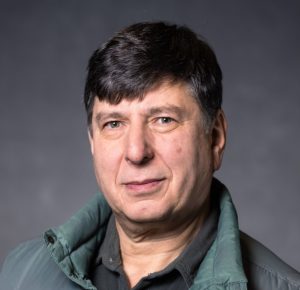
Dr Alexander Marshak
Climate and Radiation Lab
NASA
Greenbelt, MD
USA
Dr Alexander Marshak is an atmospheric scientist working in the Climate and Radiation Lab at NASA, and the Deputy Project Scientist for the DSCOVR mission. He obtained his PhD in Numerical Analysis from the Siberian Branch of the Academy of Sciences of the USSR. From 1978, he worked for 11 years at the Institute of Astrophysics and Atmospheric Physics in Estonia, before receiving an Alexander von Humboldt Fellowship to work at Göttingen University, Germany. In 1991, he joined the NASA/Goddard Space Flight Centre (GSFC). Dr Marshak has published over 170 papers in the areas of atmospheric physics, remote sensing, and shortwave radiative transfer.
CONTACT
E: alexander.marshak-1@nasa.gov
W: https://science.gsfc.nasa.gov/sed/bio/alexander.marshak-1
FUNDING
NASA
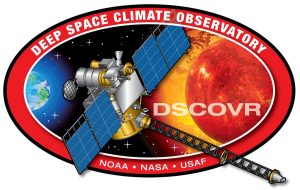
REPUBLISH OUR ARTICLES
We encourage all formats of sharing and republishing of our articles. Whether you want to host on your website, publication or blog, we welcome this. Find out more
Creative Commons Licence (CC BY 4.0)
This work is licensed under a Creative Commons Attribution 4.0 International License. 
What does this mean?
Share: You can copy and redistribute the material in any medium or format
Adapt: You can change, and build upon the material for any purpose, even commercially.
Credit: You must give appropriate credit, provide a link to the license, and indicate if changes were made.
SUBSCRIBE NOW
Follow Us
MORE ARTICLES YOU MAY LIKE
Dr Marta Berrocal-Lobo | Unlocking the Potential of Essential Oils: Illuminating Epigenetic Effects on Plant Defense Mechanisms
Essential oils (EO) are potent in enhancing plant stress responses and mitigating seed-borne diseases, particularly in high-value crops such as tomatoes. While their direct impacts are recognised, the indirect influences on plant growth, metabolism, and immune responses against phytopathogens remain uncertain. Dr Marta Berrocal-Lobo, an esteemed Associate Professor and researcher at the Polytechnic University of Madrid, in collaboration with the Group of Biopesticides led by Dr Azucena Gonzalez-Coloma, is unravelling the transcriptomic and metabolic responses of tomato seeds treated with an antifungal EO against the pathogen Fusarium oxysporum sp. Their findings pave the way for harnessing EO in sustainable agriculture.
Dr Yusuke Mori | Changing Demands and the Optimisation of Processes in Japan’s Energy Landscape
The Snake River in the northwestern United States was once home to abundant populations of Chinook salmon. However, the building of hydropower dams has led to a dramatic drop in their numbers and puzzling changes in their migratory behaviour. Dr Charles Coutant and other biologists in the region embarked on a mission to uncover exactly how these dams are interfering with the crucial downstream journey of young Chinook salmon. His creative approach, drawing on knowledge from many different fields, has revealed a hidden culprit that may be throwing these fish off course.
Dr Charles Coutant | Dams, Disruption, and the Plight of the Chinook Salmon: Unravelling the Mystery of Delayed Migration
The Snake River in the northwestern United States was once home to abundant populations of Chinook salmon. However, the building of hydropower dams has led to a dramatic drop in their numbers and puzzling changes in their migratory behaviour. Dr Charles Coutant and other biologists in the region embarked on a mission to uncover exactly how these dams are interfering with the crucial downstream journey of young Chinook salmon. His creative approach, drawing on knowledge from many different fields, has revealed a hidden culprit that may be throwing these fish off course.
Prof. Dr. Michelle van Vliet | Invisible Water Crisis: Water Scarcity is Affected by Complex Interactions of Water Quality and Sectoral Use
Sufficient water of good quality is vital for humankind and nature. A growing global population increases the demand for water of suitable quality. In addition, climate change and increases in extreme weather events, such as droughts and heatwaves, directly affect the availability, quality, and use of water. These three factors – availability, quality, and use – interact in complex ways. Prof. Dr. Michelle van Vliet at Utrecht University is pioneering our understanding of the drivers of clean water scarcity under global change and proposing solutions to this. With her team, she focuses on the challenge of ensuring sufficient water of suitable quality to meet human demands and ensuring healthy ecosystems in our changing world.

